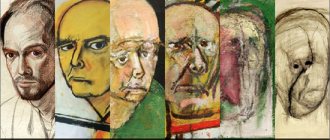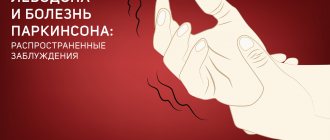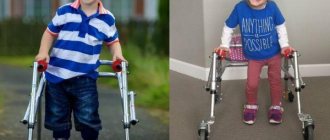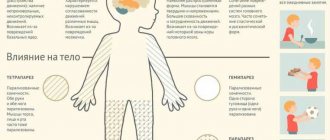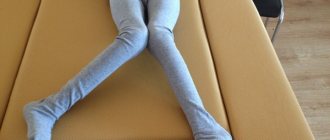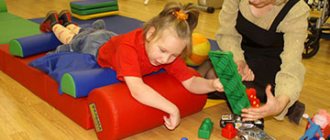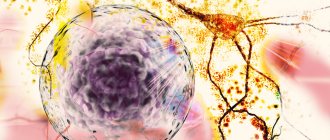Symptoms
The main features of central paralysis are muscle hypertonia, increased tendon reflexes, so-called accompanying movements, or synkinesis, and pathological reflexes. Hypertension, or muscle spasticity, determines another name for central paralysis - spastic. The muscles are tense, dense to the touch; During passive movements, a clear resistance is felt, which is sometimes difficult to overcome. This spasticity is the result of increased reflex tone and is usually unevenly distributed, leading to typical contractures. With central paralysis, the upper limb is usually brought to the body and bent at the elbow joint: the hand and fingers are also in a flexed position. The lower limb is extended at the hip and knee joints, the foot is bent and the sole is turned inward (the leg is straightened and “elongated”). This position of the limbs with central hemiplegia creates a peculiar Wernicke-Mann position, the interpretation of the patterns of occurrence of which from the point of view of the history of the development of the nervous system was given by M. I. Astvatsaturov. The gait in these cases is of a “circumducing” nature: due to the “lengthening” of the leg, the patient has to “circle” the affected leg (in order not to touch the floor with the toe). Increased tendon reflexes (hyperreflexia) are also a manifestation of increased, disinhibited, automatic activity of the spinal cord. Reflexes from the tendons and periosteum are extremely intense and are easily evoked as a result of even minor irritations: the reflexogenic zone expands significantly, i.e., the reflex can be evoked not only from the optimal area, but also from neighboring areas. An extreme degree of increase in reflexes leads to the appearance of clonus (above). In contrast to tendon reflexes, skin reflexes (abdominal, plantar, cremasteric) do not increase with central paralysis, but disappear or decrease. Concomitant movements, or synkinesis, observed with central paralysis, can occur in the affected limbs reflexively, in particular when healthy muscles are tense. Their occurrence is based on the tendency to irradiate excitation in the spinal cord to a number of neighboring segments of its own and opposite sides, which is normally moderated and limited by cortical influences. When the segmental apparatus is disinhibited, this tendency to spread excitation is revealed with particular force and causes the appearance of “additional” reflex contractions in the paralyzed muscles. There are a number of synkinesis characteristic of central paralysis. Here are some of them: 1) if the patient, according to the instructions, resists with his healthy hand the extension in the elbow joint produced by the examiner, or strongly shakes his hand with his healthy hand, then a concomitant reflex flexion occurs in the paralyzed arm; 2) the same flexion of the affected arm occurs when coughing, sneezing, or yawning; 3) under the mentioned conditions, involuntary extension is observed in the paralyzed leg (if the patient is sitting with his legs hanging over the edge of the couch or table); 4) the patient lying on his back with his legs extended is asked to adduct and abduct his healthy leg, in which he is resisted. In this case, an involuntary corresponding adduction or abduction is observed in the paralyzed leg; 5) the most constant of the accompanying movements with central paralysis is the symptom of combined flexion of the hip and trunk. When the patient tries to move from a horizontal position to a sitting position (the patient lies on his back with his arms crossed on his chest and straightened legs apart), the paralyzed or paretic leg is raised (sometimes adducted). Pathological reflexes are a group of very important and constant symptoms of central paralysis. Of particular importance are pathological reflexes on the foot, which are observed, of course, in cases where the lower limb is affected. The most sensitive symptoms are Babinski (perverted plantar reflex), Rossolimo and Bekhterev. The remaining pathological reflexes on the foot (above) are less constant. Pathological reflexes in the hands are usually weakly expressed and have not acquired much significance in the practice of clinical research. Pathological reflexes on the face (mainly a group of “oral” reflexes) are characteristic of central paralysis or paresis of muscles innervated by cranial nerves, and indicate bilateral supranuclear lesions of the tractus cortico-bulbaris in the cortical, subcortical or brainstem regions. Symptoms such as increased tendon reflexes of the limbs, weakened abdominal reflexes and Babinski's symptom are very subtle and early signs of a violation of the integrity of the pyramidal system and can be observed when the lesion is not yet sufficient to cause paralysis or even paresis. Therefore, their diagnostic value is very great. E. L. Venderovich described the symptom of “ulnar motor defect”, indicating a very mild degree of pyramidal lesion: on the affected side the patient’s resistance to forced abduction towards the maximum of the fourth finger of the little finger is weaker.
Symptoms of cerebral palsy
The main manifestation of cerebral palsy is impaired motor activity. Mental disorders in a child are diagnosed much later, when cognitive processes are actively developing. Unlike movement disorders, which can be diagnosed immediately after birth, mental disorders are diagnosed at the age of 2-3 years.
Diagnosing cerebral palsy after birth is quite difficult, since the child has virtually no motor skills during this period. Most often, the diagnosis is confirmed at the residual stage, starting at 6 months.
The pathology is accompanied by the following symptoms:
- Delays in the development of motor activity. In pediatrics, the average time for a child to develop certain motor skills has been determined. For example, a child early learns to roll over on his stomach, reach for objects of interest to him, hold his head up, and later sit or crawl. A delay in the development of such skills indicates the possibility of cerebral palsy.
Other physical activity
Lack of reflex activity. A child is born with a set of unconditioned reflexes, which fade away at a certain age, being replaced by acquired ones. If a reflex that is characteristic of infancy appears in an older child, this indicates the presence of cerebral pathology. A striking example is the grasping reflex, which normally disappears at 5 months. Muscle tone disorders. The disorder is diagnosed by a pediatric neurologist. It manifests itself in the form of sudden slow movements in the limbs, which are performed by the child without any purpose. Use of one limb. In the absence of any pathologies, the child’s motor activity manifests itself equally in all parts of the body. If the pathology develops, the regular use of one limb when performing certain actions is noted. For example, a child may constantly reach with one hand while the other remains idle. The presence of such a symptom is a serious reason to visit a doctor.
In general, there are various symptoms of cerebral palsy that occur at an early stage of the pathology.
Causes
Spastic paralysis occurs due to damage to the motor neuron. Since the arrangement of cells and fibers of the pyramidal bundles is quite close, central paralysis is usually diffuse, spreading to an entire limb or half of the body. Peripheral paralysis may be limited to damage to certain muscle groups or even individual muscles. There may, however, be exceptions to this rule. Thus, a small lesion in the cerebral cortex can cause the occurrence of isolated central paralysis of the foot, face and; conversely, multiple diffuse lesions of the nerves or anterior horns of the spinal cord sometimes cause widespread paralysis of the peripheral type. The most common causes of spasticity are stroke, traumatic brain and spinal injuries, perinatal encephalopathy (cerebral palsy) and multiple sclerosis. Spasticity is caused by an imbalance in nerve impulses. Which are sent by the nervous system to the muscles. It leads to increased tone of the latter. Other causes of spasticity: * Brain injuries. * Spinal cord injury. * Brain damage due to lack of oxygen (hypoxia). * Stroke. * Encephalitis (inflammation of brain tissue). * Meningitis (inflammation of the tissue around the brain). * Adrenoleukodystrophy. * Amyotrophic lateral sclerosis. * Phenylketonuria.
Cerebral palsy atonic-astatic form ICD 10 code
G80.0 Spastic tetraplegia
(If movement disorders in the hands are more severe, the clarifying term “bilateral hemiplegia” can be used)
G80.0 One of the most severe forms of cerebral palsy, resulting from abnormalities in brain development, intrauterine infections and perinatal hypoxia with diffuse damage to the cerebral hemispheres. In premature infants, the main cause of perinatal hypoxia is selective neuronal necrosis and periventricular leukomalacia; in full-term infants - selective or diffuse necrosis of neurons and parasagittal brain damage during intrauterine chronic hypoxia. Clinically diagnosed are spastic quadriplegia (quadriparesis; a more appropriate term[3] compared to tetraplegia, since noticeable impairments are detected approximately equally in all four limbs), pseudobulbar syndrome, visual impairment, cognitive and speech impairment. 50% of children experience epileptic seizures. This form is characterized by the early formation of contractures, deformations of the trunk and limbs. In almost half of the cases, movement disorders are accompanied by pathology of the cranial nerves: strabismus, atrophy of the optic nerves, hearing impairment, and pseudobulbar disorders. Quite often, microcephaly is noted in children, which, of course, is secondary. Severe motor defects of the hands and lack of motivation exclude self-care and simple work activities.
Treatment
There are several treatments for spasticity. All of them have the following goals: * Relief of spasticity symptoms. * Reducing pain and muscle spasm. * Improvement of gait, daily activity, hygiene and care. * Facilitation of voluntary movements. Physiotherapy treatments for spasticity: Physiotherapy is used to reduce muscle tone and improve movement, strength and muscle coordination. Drug therapy for spasticity: The use of drug therapy is indicated for daily disruption of normal muscle activity. Effective drug treatment involves the use of two or more drugs in combination with other treatment methods. Drugs used for spasticity include: * Baclofen. * Benzodiazepines. * Datrolene. * Imidazoline. * Gabaleptin. Botulinum toxin injections for spasticity: Botulinum toxin, also known as Botox, is effective in very small amounts when injected into paralyzed muscles. When Botox is injected into a muscle, the action of the neurotransmitter acetylcholine, which helps transmit impulses in nerves, is blocked. This leads to muscle relaxation. The effect of the injection begins within a few days and lasts about 12 – 16 weeks. Surgical treatment of spasticity: Surgical treatments include intrathecal baclofen and selective dorsal rhizotomy. Intrathecal administration of baclofen. For severe cases of spasticity, baclofen is given by injecting directly into the cerebrospinal fluid. To do this, an ampoule with baclofen is implanted into the skin of the abdomen. Selective dorsal rhizotomy. In this operation, the surgeon cuts certain nerve roots. This method is used to treat severe spasticity that interferes with normal walking. In this case, only the sensory nerve roots are crossed.

